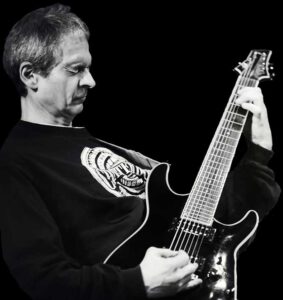I am the first one to admit that over my entire guitar playing career, I have never had a really great guitar tone. Where many of my guitar playing colleagues developed into instrument and amp experts (dare I say nerds) and often spent substantial amounts of money on just the right, often vintage, guitar, this was secondary for me. There rarely was a gig in my career on which I didn’t bitch about my sound (then again I heard other guitar players with much more professional equipment having mediocre tone and bitch about it.)
In the beginning years, this had much to do with the fact that instruments and amps of any kind weren’t cheap. And I never had enough money. I think over the years, I simply learned to live with the flaws of my sound or tone. As a matter of fact, in the meantime I actually like the flaws and shortcomings of many of my instruments.
It’s a bit different with amplification. While I really like my 100W Carvin tube combo, it’s a little too powerful for many shows. For those smaller venues I had been using a 30W Epiphone tube amp until it blew up one night, emitting a pretty bad smell. It’s still on my workbench for repair. It was replaced by a used Crate Blue Voodoo 60W combo which I would consider to be the best sounding amp I ever owned (contrary to many guitarists’ opinions). I had bought the Crate used in 2014 and this Summer, 2017, it also fizzled out on a gig. This happened just before our European tour in June and it went undiagnosed and unrepaired until we came back (replacing all the power capacitors did the trick.)
Since it’s a bit unrealistic to take an amp on an airplane these days, I was dependent on whatever backline the venue offered, although on the second half of the German leg, I was able to use a friend’s Fender Classic 30. That was a sweet amp and fit well in the car. I had the iPad with me, thinking I would use it for guitar effects, but the small connectors are just a little unreliable. We did a show in Berlin where I used the house amp – I think a Yamaha Series II. Sounded okay, but fighting all night to get a halfway decent tone takes away from the playing. Then there was the club in Edinburgh, Scotland, which had a guitar amp I don’t remember the brand of. It worked okay and after a while I just stopped worrying. Next night we rode the train to Glasgow. The club there only had a bass amp and a keyboard with a PA. That was when I was really grateful for the iPad. Going into the PA system straight from the iPad wasn’t perfect, and having little control over the monitor speaker to actually hear myself, it wasn’t very comfortable either. But, after I listened to the recording from that night, the guitar sounded actually quite good in the room.
After we came back from the tour, with a nice calendar full of shows and the Crate Blue Voodoo still in my shop, not making a peep, I followed up on a recommendation of a friend I had talked to after one of the German concerts. He had told me that for the past few years, his live setup has been Native Instruments’ Guitar Rig software running on an old MacBook Pro. I have been using Guitar Rig in my own studio recording for years but never thought about using it in a live situation. The key was the Rig Control pedal, which can be programmed to switch patches or other functions in the software, but also functions as input/output device. Some online research showed that Native Instruments didn’t make that pedal anymore. But I was lucky to find a used one. Another problem was to find the most recent MacOS version the drivers would run on – they didn’t work on the latest OS “Sierra”. So I spent a weekend installing all accessible MacOS X versions on a large external hard drive. Actually a good thing to test other software. It seemed to work best on “Yosemite”.
It took a few hours to create some usable patches. When I had used Guitar Rig in the studio before, I always started with one of the factory presets, not spending much time on creating my own sound. For the live situation, I started with a few amp simulations that sounded good with my main guitars. Only then did I start to add some effects like I had in my regular pedals, such as chorus, delay, wah-wah, and a really nice slow/fast Leslie.
I have used this setup now for a few months and I like it. The setup travels easily, with the computer and the pedal in a small backpack with all the cables. When I drive to a gig I usually bring a small active PA speaker to have a personal monitor. Sometimes feels a little strange to twiddle virtual amp controls on a computer screen rather than physical knobs on an amp and even though computer latency is as low as 32ms (that’s how long it takes between the sound from the guitar going into the computer, being processed and coming out to the amp) it can still feel a little “disconnected”. But I like that I can get a somewhat consistent sound – even if it’s not a perfect.

